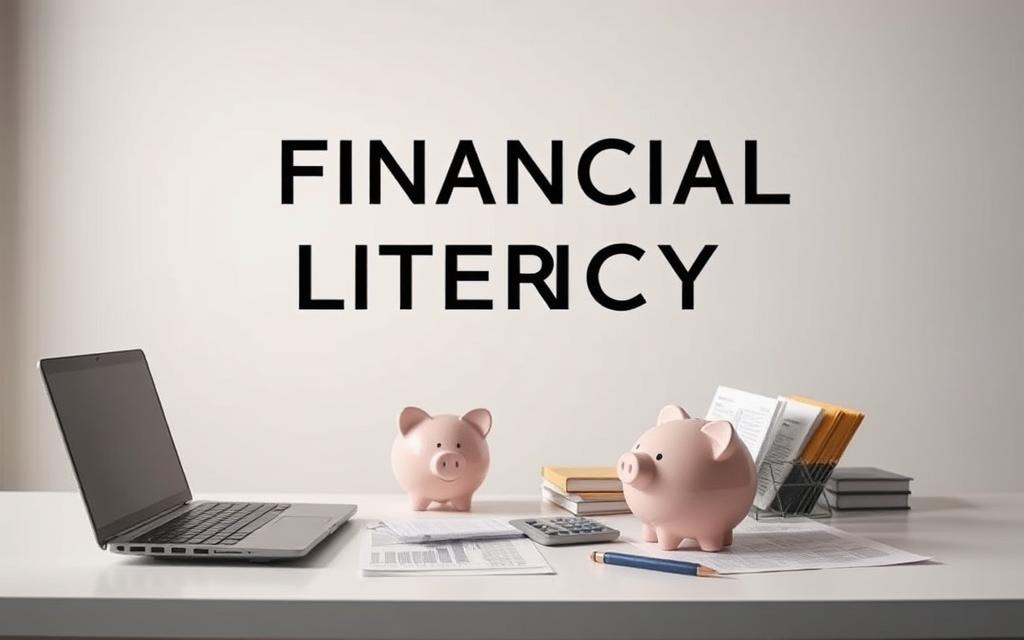Financial literacy is a crucial aspect of modern life, yet many individuals lack a basic understanding of financial concepts. According to a recent Eurobarometer survey published in July 2023, only 18% of European Union citizens have a high level of financial literacy.
A person not educated in finance often struggles with everyday financial decisions, leading to detrimental outcomes for themselves and their families. Research by the Financial Industry Regulatory Authority (FINRA) showed that approximately two-thirds of Americans cannot pass a basic test on simple concepts like inflation and interest.
This lack of financial knowledge can have far-reaching consequences, making it essential to understand the characteristics and implications of financial illiteracy. By exploring the scope of this issue, we can better appreciate the importance of financial education in today’s complex economic landscape.
Understanding Financial Illiteracy in Today’s World
The prevalence of financial illiteracy poses significant challenges for individuals and societies alike. Financial illiteracy refers to the lack of knowledge and skills necessary to make informed decisions about personal finances, including budgeting, saving, and investing.
The Scope of the Problem
Research indicates a concerning trend in financial literacy levels among adults. According to data from the FINRA Foundation, the percentage of U.S. adults with a basic understanding of investment risks declined from more than half in 2009 to 42.1% in 2021. This downward trend highlights the need for improved financial education. Certain demographic groups, such as women, younger individuals, and those with lower incomes or education levels, are disproportionately affected by financial illiteracy.
| Demographic Group | Financial Literacy Rate |
|---|---|
| Women | Lower than average |
| Younger Individuals | Lower than average |
| Lower Income | Significantly lower |
Why Financial Literacy Matters More Than Ever
In today’s complex financial landscape, financial literacy is crucial for navigating various financial products and making informed decisions. The shift from defined-benefit to defined-contribution pension schemes has increased personal responsibility for retirement planning, further emphasizing the need for financial knowledge. As financial systems become more sophisticated, individuals face increasingly complex financial decisions, making financial literacy essential for achieving financial stability and security.
Understanding the impact of financial illiteracy is vital for addressing its consequences. By promoting financial education and improving literacy levels, individuals and societies can mitigate the problems associated with financial illiteracy.
A Definition of a Person Not Educated in Finance
A person not educated in finance is someone who lacks the skills and confidence to make informed decisions about their personal finances. This lack of financial literacy can lead to a range of problems, from ineffective budgeting to poor investment choices.

Key Characteristics and Knowledge Gaps
Individuals who are not financially literate often exhibit certain characteristics, including an inability to create and maintain a budget, a lack of understanding about interest rates and compound interest, and confusion about credit scores and their importance. They may also have a poor understanding of investment principles and struggle to differentiate between various financial products and services.
- Lack of understanding of basic financial concepts, such as compound interest and credit scores.
- Inability to manage debt effectively.
- Poor investment decisions due to a lack of knowledge about investment products.
Common Misconceptions About Money and Banking
Many individuals hold misconceptions about how banks operate, how credit works, and how monetary policy affects personal finances. For instance, a survey in 2020 showed that 38% of respondents believed that banks had to have the exact amount of customer deposits in their reserves at all times, demonstrating a significant misunderstanding of fractional reserve banking.
Such misconceptions can lead to poor financial decision-making, perpetuating a cycle of financial struggles. Financial education is crucial in addressing these knowledge gaps and empowering individuals to manage their finances effectively.
The Current State of Financial Literacy
Understanding the current state of financial literacy is essential for addressing the gaps in financial knowledge. Recent research has highlighted the complexity of this issue, revealing significant disparities across different demographic groups and regions.
Statistics in the United States
The United States has its own set of challenges regarding financial literacy. According to the 2021 National Financial Capabilities Survey (NFCS) conducted by the Financial Industry Regulatory Authority Foundation (FINRA), respondents with low financial literacy were more likely to overspend relative to their income and less likely to have emergency funds or retirement plans. The survey underscores the need for improved financial education.
A significant percentage of the population lacks basic financial knowledge, with certain groups, such as women and younger individuals, being disproportionately affected.
Global Comparisons and Trends
Globally, the picture is similarly concerning. A recent Eurobarometer survey revealed wide differences in literacy levels across European member states. Only four countries had more than 25 percent of their population scoring highly in financial literacy. The gap was more pronounced among certain demographic groups, including women, younger people, and those with lower incomes or education levels.
Comparing financial literacy across different countries and regions highlights the influence of cultural, educational, and policy factors on level financial literacy. Understanding these differences is crucial for developing targeted interventions to improve financial knowledge.
How Financial Illiteracy Affects Personal Life
The lack of financial knowledge can lead to a myriad of problems in personal life, from budgeting challenges to debt accumulation. Financial illiteracy affects individuals in various ways, making it difficult for them to manage their finances effectively.
Impact on Day-to-Day Financial Decisions
Financial illiteracy significantly impacts day-to-day financial decisions, leading to issues such as budgeting challenges and inappropriate use of credit. Individuals who lack financial knowledge often struggle with creating and maintaining a budget, leading to overspending and accumulation of debt. Moreover, they may be vulnerable to predatory lending practices and have difficulty managing unexpected expenses.
For instance, the average American lost $1,819 to personal financial errors last year, as highlighted by the National Financial Educators Council (NFEC) report. Credit card interest rates and fees are significant traps for those with lower financial literacy, costing consumers $120 billion in 2022. Additionally, overdraft fees are a substantial burden, with Americans spending $17 billion annually on overdraft and non-sufficient funds (NSF) fees, according to the Consumer Financial Protection Bureau (CFPB).
| Financial Challenges | Consequences | Estimated Annual Cost |
|---|---|---|
| Credit Card Interest Rates and Fees | Accumulation of Debt | $120 billion |
| Overdraft and NSF Fees | Additional Financial Burden | $17 billion |
| Financial Mistakes | Loss of Money | $1,819 per person |
Long-Term Consequences for Individuals and Families
The long-term consequences of financial illiteracy are severe and can affect not only individuals but also their families. Chronic debt, inability to build emergency savings, inadequate retirement planning, and limited wealth accumulation are some of the long-term effects. Furthermore, financial illiteracy can create intergenerational cycles of financial struggle, as parents who lack financial knowledge are less able to teach their children sound money management principles.
For example, without emergency funds, individuals are more likely to fall into debt when faced with unforeseen expenses or financial emergencies. This can lead to a cycle of debt that is difficult to escape, ultimately affecting their financial stability and security.

In conclusion, financial illiteracy has a profound impact on both day-to-day financial decisions and long-term financial stability. It is essential to address this issue through financial education and awareness, enabling individuals to make informed financial decisions and secure their financial future.
The Societal Impact of Financial Illiteracy
Widespread financial illiteracy can have significant societal implications, including economic inefficiencies and poor decision-making. The consequences of financial illiteracy extend beyond the individual, affecting the broader economy and societal structures.
Economic Consequences at the National Level
Financial illiteracy contributes to economic inefficiencies, including reduced productivity and increased welfare dependency. When a significant portion of the population lacks understanding of basic financial concepts, it can lead to poor financial decisions, ultimately affecting the national economy. For instance, a lack of understanding about interest rates and inflation can lead to poor investment decisions.
Some of the key economic consequences include:
- Increased costs for financial regulation and consumer protection
- Reduced economic productivity due to poor financial decision-making
- Increased welfare dependency among those who are financially illiterate
How It Undermines Democratic Decision-Making
Financial illiteracy also undermines democratic decision-making by making citizens less able to evaluate policy proposals and hold elected officials accountable. When people lack a basic understanding of financial concepts, such as government budgets and monetary policy, they are more susceptible to misinformation and less likely to make informed decisions at the ballot box.
A survey by Dods Political Intelligence in 2017 highlighted that even Members of the British Parliament had a limited understanding of money creation, with only 15 percent aware that new money is created when banks make loans. This lack of understanding among both the general public and policymakers underscores the complexity of the issue.
The implications are significant, as financially illiterate populations are more likely to support populist economic policies that promise simple solutions to complex problems, potentially leading to harmful long-term economic consequences.
Financial Education: Current Approaches and Gaps
As the global economy becomes increasingly complex, the need for effective financial education has never been more pressing. Financial literacy is a vital skill that enables individuals to make informed decisions about their financial resources, yet it remains a neglected area in many parts of the world.
Financial Education in Schools
A report from the Council for Economic Education (CEE) found that although all 50 states plus Washington, D.C., included economics in their K-12 social studies standards, only 25 states required students to complete an economics class to graduate high school as of 2022. The number of states that included personal finance in their K-12 social studies standards increased from 21 to 47 between 1998 and 2022.
| Year | Number of States with Economics in K-12 Standards | Number of States Requiring Economics to Graduate | Number of States with Personal Finance in K-12 Standards | Number of States Requiring Personal Finance to Graduate |
|---|---|---|---|---|
| 1998 | 47 | 16 | 21 | 1 |
| 2022 | 51 | 25 | 47 | 23 |
Alternative Learning Resources and Their Effectiveness
Research reviews find that teaching personal finance in schools has a positive effect on students’ financial literacy and economic behavior. A 2022 study conducted in Georgia and Texas found that students who received personal finance instruction had higher credit scores and were less likely to be delinquent on credit card payments. Alternative learning resources, such as online courses and mobile applications, are also becoming increasingly popular.

These resources offer flexible and accessible ways for individuals to improve their financial literacy. However, there are significant gaps in current financial education approaches, including inadequate teacher training, outdated curriculum content, and insufficient resources.
Addressing Financial Illiteracy: Potential Solutions
To combat financial illiteracy, it’s essential to implement comprehensive solutions that address the issue at individual, institutional, and policy levels. This involves a multi-faceted approach that includes enhancing financial education in schools, leveraging technology, and promoting collaboration among various stakeholders.
Educational Reforms and Initiatives
Improving financial literacy in schools is crucial. There is growing bipartisan support for mandating personal finance courses in high schools. For instance, Republican Senator Chris Gebhard sponsored a bill in Pennsylvania requiring a personal finance course for graduation. Similarly, Democratic Governor Gretchen Whitmer signed a bill in Michigan making financial literacy instruction mandatory in public schools. These initiatives aim to equip students with necessary money management skills for lifetime success.
Technology and Tools for Improving Financial Literacy
The rise of modern financial tools and platforms has also contributed to improved financial literacy. Many personal finance apps and trading platforms used by the younger generation have built-in financial literacy lessons. These innovative tools make learning about finance more engaging and accessible, teaching users about credit, debt, and other financial concepts. By leveraging technology, individuals can gain the knowledge needed to make informed financial decisions.

Conclusion: The Path Forward to Financial Empowerment
Financial illiteracy is a pervasive issue that affects not only individuals but also the broader economy, making it imperative to address this problem through education and awareness. The lack of financial knowledge among a significant portion of the population poses a substantial challenge to economic stability and growth.
Improving financial literacy is crucial for empowering individuals to make informed financial decisions, thereby enhancing their economic well-being and contributing to a more stable economy. The National Standards for Personal Financial Education provide a comprehensive framework for teaching personal finance in schools, covering topics such as earning income, spending, saving, investing, credit, and managing risk.
To move forward, it is essential to adopt a multifaceted approach that includes educational reforms, leveraging technology, and promoting awareness about the importance of financial literacy. By working together, we can create a financially literate society where individuals are equipped to manage their finances effectively, contributing to a stronger, more resilient economy.













